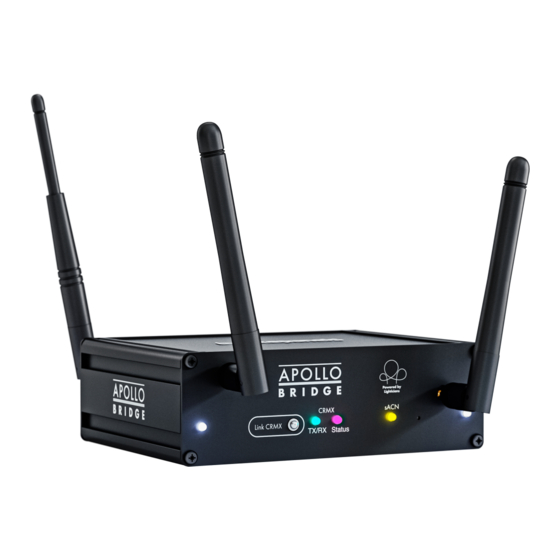
Summary of Contents for Litepanels Apollo
- Page 1 Users Manual Apollo Wireless DMX Bridge Powered By Lighticians Part No. 900-4014 www.litepanels.com...
- Page 2 Copyright © 2020 All rights reserved. Original Instructions: English All rights reserved throughout the world. No part of this publication may be stored in a retrieval system, transmitted, copied or reproduced in any way, including, but not limited to, photocopy, photograph, magnetic or other record without the prior agreement and permission in writing of the Vitec Group Plc.
-
Page 3: Table Of Contents
Contents Safety . . . . . . . . . . . . . . . . . . . . . . . . . . . . . . . . . . . . . 2 Specifications . -
Page 4: Safety
There are no user serviceable parts inside the enclosure. Only a Litepanels qualified service center may open the Apollo Bridge. Health and Safety The Apollo system is intended for professional use and may only be WARNING! Risk of personal injury or injury to others. All operated by qualified persons. - Page 5 Dimensions Maximum spread: 190mm 7.5” 42mm 1.7” 144mm 104mm 5.7” 5.7”...
-
Page 6: Features
Dual 1Gbps Ethernet Ports supporting two separate networks, most crowded radio frequency environments. WAN/LAN routing functionality, or bridged as a switch. The Apollo Bridge also is an enterprise grade network router that can • LumenRadio TimoTwo CRMX transceiver. be configured for sophisticated data networking. Configuration and provisioning is performed using an intuitive web based interface from •... -
Page 7: Elements
The Apollo Wireless DMX Bridge includes 2× RP-SMA antennae for dual band WiFi, and 1× RP-TNC antenna for CRMX transmission. To control all of your Litepanels lights and other lighting fixtures in your kit, scan the QR code with your iPhone or iPad to install the app. -
Page 8: Operating Elements
Operating Elements Front View Rear View Dual-band 2 .4GHz and 5GHz Antennas sends and receives sACN Wi-Fi Reset Pinhole Button press to reboot or hold for 3 seconds to reset to transmission factory default settings Long LumenRadio CRMX Antenna transmits wireless DMX to CRMX LAN RJ45 Port connect to sACN Local Area Network devices such as receivers a lighting console... -
Page 9: Led Indicators
White slow flashing System booting White fast flashing Press “RESET” button to enter failsafe Pink fast flashing Contact Litepanels Support Yellow very fast flashing System is in failsafe mode Orange very fast flashing Contact Litepanels Support USB-C supply has insufficient power, try switching to a different... -
Page 10: Operation
USB-C connector into the female seconds in unison with the CRMX Status Light on linking CRMX input on the rear of the Apollo Bridge. Then connect to an AC power receivers. Linking is complete when flashing stops. - Page 11 Now that your tablet or device is connected and your receivers are On your Gemini Select WIRELESS DMX > UNLINK (this linked, open the Lighticians’ Apollo Control app or another sACN resets the dongle and unlinks from any transmitter it may have compatible lighting control application of your choice.
-
Page 12: Device Configuration
DMX Bridge WiFi using the SSID and password displayed on Connect power to the Apollo Wireless DMX Bridge. the bottom of the Apollo Bridge; or connect your PC to the LAN Press and hold the recessed reset button inside the small Ethernet port. -
Page 13: Updating Firmware
10. Once the LED indicators finish breathing and become solid, you will be able to reconnect to the Apollo wireless network and operate the device. Select Upload . 11. Settings are preserved through firmware updates so it is likely that your WiFi connected devices will automatically reconnect. -
Page 14: Radio Frequency, Interference Management
Operation Advanced Capabilities Multi-Universe Networks In addition to acting as a self contained WiFi network, the Apollo If more than one universe is required, several Apollo Wireless DMX Wireless Bridge has several other ways of controlling and connecting Bridges can be set to different universe numbers and connected lighting devices. -
Page 15: Selecting A Wifi Channel
This can be configured within the Advanced Settings pages within the web controls. Dense WiFi Environments 5GHz WiFi is built into the Apollo Bridge and enabled by default. Any device supporting 5GHz WiFi will automatically connect using those frequencies instead of the typically more crowded 2.4GHz band. In environments with extremely high device counts or with numerous other 2.4GHz/5GHz networks —... -
Page 16: Troubleshooting
Troubleshooting Troubleshooting Check that the Apollo Bridge is receiving reliable power and that Tips all physical connections are firmly seated. When troubleshooting When Connecting with an iOS/iPadOS Device “mysterious” failures, reduced range, or sudden signal issues the solution often can be switching the power source. -
Page 17: Kits / Spare Parts
- Apollo Bridge, w/ Power Supply, w/ Antennas, w/ case, w/ Six (6) ASTRA Wireless DMX Modules 900-4018 - Apollo Bridge, w/ P/S, w/ Antennas, w/ case, w/ Three (3) GEMINI Comms Wireless DMX Dongles, w/ Three (3) ASTRA Wireless DMX Modules Spare Parts... -
Page 18: Specifications
Power Supply USB Type C (9V/2A) WiFi Frequency Bands Simultaneous Dual Band 2.4 GHz and 5 GHz Platform Compatibility Apollo App, Luminair App, ETC WiFi Standard 802.11ac Wave2 with MIMO (including Nomad), GrandMA, Strand DMX, sACN consoles and controllers Range (line-of-sight) -
Page 19: General Notices
General Notices FCC statement EU Declaration of Conformity Note: This equipment has been tested and found to comply with the This product complies with the following EU Directives: limits for a Class A digital device, pursuant to part 15 of the FCC Rules. - Page 20 Publication No. 1.0...
